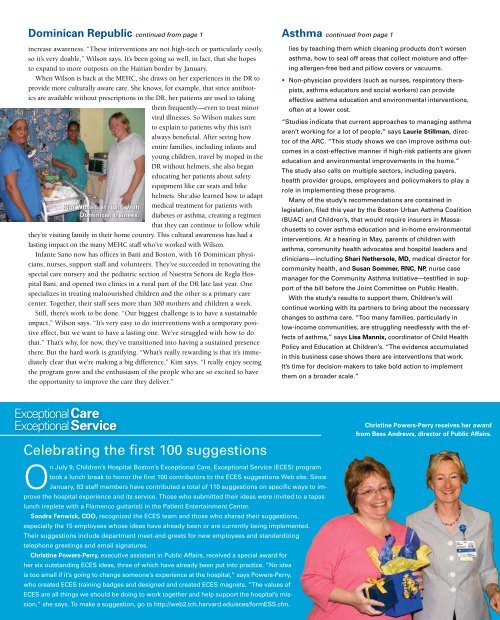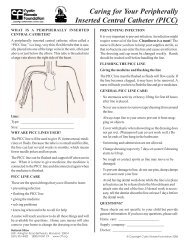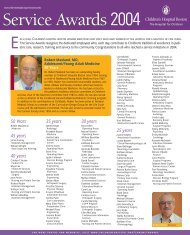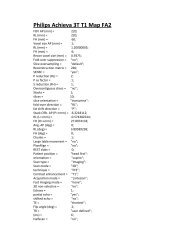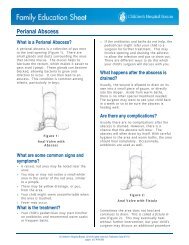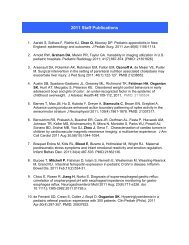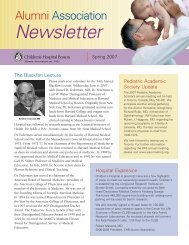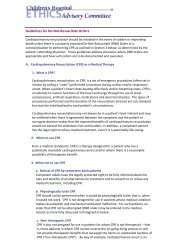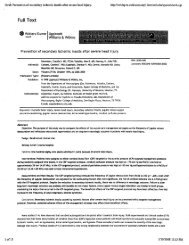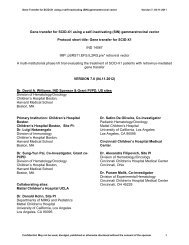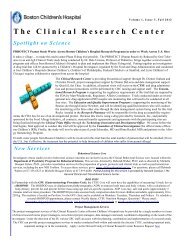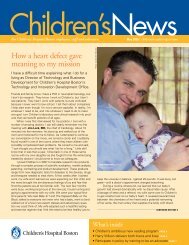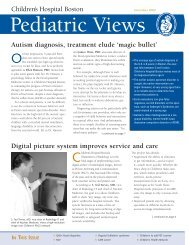Mission: Possible - Children's Hospital Boston
Mission: Possible - Children's Hospital Boston
Mission: Possible - Children's Hospital Boston
You also want an ePaper? Increase the reach of your titles
YUMPU automatically turns print PDFs into web optimized ePapers that Google loves.
Dominican Republic continued from page 1<br />
increase awareness. “These interventions are not high-tech or particularly costly,<br />
so it’s very doable,” Wilson says. It’s been going so well, in fact, that she hopes<br />
to expand to more outposts on the Haitian border by January.<br />
When Wilson is back at the MEHC, she draws on her experiences in the DR to<br />
provide more culturally aware care. She knows, for example, that since antibiotics<br />
are available without prescriptions in the DR, her patients are used to taking<br />
them frequently—even to treat minor<br />
viral illnesses. So Wilson makes sure<br />
to explain to patients why this isn’t<br />
always beneficial. After seeing how<br />
entire families, including infants and<br />
young children, travel by moped in the<br />
DR without helmets, she also began<br />
educating her patients about safety<br />
equipment like car seats and bike<br />
helmets. She also learned how to adapt<br />
Kim Wilson, at right, with<br />
Dominican trainees.<br />
medical treatment for patients with<br />
diabetes or asthma, creating a regimen<br />
that they can continue to follow while<br />
they’re visiting family in their home country. This cultural awareness has had a<br />
lasting impact on the many MEHC staff who’ve worked with Wilson.<br />
Infante Sano now has offices in Bani and <strong>Boston</strong>, with 16 Dominican physicians,<br />
nurses, support staff and volunteers. They’ve succeeded in renovating the<br />
special care nursery and the pediatric section of Nuestra Señora de Regla <strong>Hospital</strong><br />
Bani, and opened two clinics in a rural part of the DR late last year. One<br />
specializes in treating malnourished children and the other is a primary care<br />
center. Together, their staff sees more than 300 mothers and children a week.<br />
Still, there’s work to be done. “Our biggest challenge is to have a sustainable<br />
impact,” Wilson says. “It’s very easy to do interventions with a temporary positive<br />
effect, but we want to have a lasting one. We’ve struggled with how to do<br />
that.” That’s why, for now, they’ve transitioned into having a sustained presence<br />
there. But the hard work is gratifying. “What’s really rewarding is that it’s immediately<br />
clear that we’re making a big difference,” Kim says. “I really enjoy seeing<br />
the program grow and the enthusiasm of the people who are so excited to have<br />
the opportunity to improve the care they deliver.”<br />
Exceptional Care<br />
Exceptional Service<br />
Celebrating the first 100 suggestions<br />
On July 9, Children’s <strong>Hospital</strong> <strong>Boston</strong>’s Exceptional Care, Exceptional Service (ECES) program<br />
took a lunch break to honor the first 100 contributors to the ECES suggestions Web site. Since<br />
January, 83 staff members have contributed a total of 110 suggestions on specific ways to improve<br />
the hospital experience and its service. Those who submitted their ideas were invited to a tapas<br />
lunch (replete with a Flamenco guitarist) in the Patient Entertainment Center.<br />
Sandra Fenwick, COO, recognized the ECES team and those who shared their suggestions,<br />
especially the 15 employees whose ideas have already been or are currently being implemented.<br />
Their suggestions include department meet-and-greets for new employees and standardizing<br />
telephone greetings and email signatures.<br />
Christine Powers-Perry, executive assistant in Public Affairs, received a special award for<br />
her six outstanding ECES ideas, three of which have already been put into practice. “No idea<br />
is too small if it’s going to change someone’s experience at the hospital,” says Powers-Perry,<br />
who created ECES training badges and designed and created ECES magnets. “The values of<br />
ECES are all things we should be doing to work together and help support the hospital’s mis-<br />
Asthma continued from page 1<br />
lies by teaching them which cleaning products don’t worsen<br />
asthma, how to seal off areas that collect moisture and offering<br />
allergen-free bed and pillow covers or vacuums.<br />
• Non-physician providers (such as nurses, respiratory therapists,<br />
asthma educators and social workers) can provide<br />
effective asthma education and environmental interventions,<br />
often at a lower cost.<br />
“Studies indicate that current approaches to managing asthma<br />
aren’t working for a lot of people,” says Laurie Stillman, director<br />
of the ARC. “This study shows we can improve asthma outcomes<br />
in a cost-effective manner if high-risk patients are given<br />
education and environmental improvements in the home.”<br />
The study also calls on multiple sectors, including payers,<br />
health provider groups, employers and policymakers to play a<br />
role in implementing these programs.<br />
Many of the study’s recommendations are contained in<br />
legislation, filed this year by the <strong>Boston</strong> Urban Asthma Coalition<br />
(BUAC) and Children’s, that would require insurers in Massachusetts<br />
to cover asthma education and in-home environmental<br />
interventions. At a hearing in May, parents of children with<br />
asthma, community health advocates and hospital leaders and<br />
clinicians—including Shari Nethersole, MD, medical director for<br />
community health, and Susan Sommer, RNC, NP, nurse case<br />
manager for the Community Asthma Initiative—testified in support<br />
of the bill before the Joint Committee on Public Health.<br />
With the study’s results to support them, Children’s will<br />
continue working with its partners to bring about the necessary<br />
changes to asthma care. “Too many families, particularly in<br />
low-income communities, are struggling needlessly with the effects<br />
of asthma,” says Lisa Mannix, coordinator of Child Health<br />
Policy and Education at Children’s. “The evidence accumulated<br />
in this business case shows there are interventions that work.<br />
It’s time for decision-makers to take bold action to implement<br />
them on a broader scale.”<br />
Christine Powers-Perry receives her award<br />
from Bess Andrews, director of Public Affairs.<br />
In their own words<br />
Kitty Scott, RN, retired coordinator of Patient Relations<br />
A nurse looks back on 5 years at Children’s<br />
In 1962, I came to Children’s <strong>Hospital</strong> <strong>Boston</strong><br />
as a young nurse with a plan to work at the<br />
hospital for one year and then return home<br />
to Nova Scotia. I’d written a letter to the Nursing<br />
Department explaining my limited experience<br />
and desire for a job. I received a letter<br />
of acceptance with a start date. There was no<br />
interview and I completed my application after I<br />
arrived. My salary was $82 a week.<br />
I was assigned to Division 35, the cardiology/cardiac<br />
surgical unit. My head nurse did not<br />
meet me until I had completed a few days of<br />
orientation and I worked just a few days with a<br />
senior nurse and then was on my own.<br />
There were no intensive care units (ICUs)<br />
at Children’s when I arrived. We cared for<br />
patients who had open heart surgery in the<br />
“Pump Room.” If patients required a ventilator,<br />
they remained in the Recovery Room (now<br />
the Pediatric Advanced Care Unit) but nursing<br />
staff from Division 35 provided the care. In<br />
some cases, patients were so unstable they<br />
remained on the OR table while we cared for<br />
them. Back then, open heart surgery couldn’t<br />
be done until the child reached 45 pounds<br />
because our heart-lung machine wasn’t adapted<br />
for babies, so many children died waiting for<br />
surgery. Some “blue babies” had palliative procedures<br />
done in the hyperbaric chamber, which<br />
was located in the basement of the Harvard<br />
School of Public Health—now the Wolbach<br />
Building. Imagine the challenge of transporting<br />
a baby across the garden to the hospital following<br />
surgery, sometimes in the dark.<br />
In December of 1964, a very exciting thing<br />
occurred. A Cardiac ICU (CICU) was opened<br />
on Division 25, the first pediatric ICU in the<br />
country. I assisted in transferring the first<br />
patient into the unit. A month later, I became<br />
Assistant Head Nurse for the night shift. In<br />
those days, nurses didn’t apply for promotions,<br />
but were chosen by nursing leadership. It<br />
wasn’t unusual to work up to 10 shifts in a row.<br />
In addition to a modest raise, this new position<br />
gave me every other weekend off—regular<br />
staff nurses worked eight-hour shifts and<br />
worked two out of three weekends. Providing<br />
adequate coverage was the priority, and the<br />
nurses’ personal lives came second. As nurses,<br />
we wore totally white uniforms, white shoes<br />
and stockings, and, of course, the cap that<br />
represented the school of nursing from which<br />
we graduated.<br />
Parents did not stay at<br />
the hospital at night unless<br />
the child was critically ill,<br />
and at 8 p.m., all visitors<br />
left. Parents were not<br />
encouraged to participate<br />
in their child’s care, so the<br />
staff nurses provided all<br />
care, except perhaps an<br />
occasional diaper change<br />
or bottle feeding. Except at<br />
the highest level of nursing<br />
administration, nurses were<br />
not involved in decisionmaking<br />
of the hospital. Staff<br />
nurses did not serve on any<br />
hospital-wide committees<br />
and annual reviews were<br />
done by the supervisors<br />
with no peer input. Promotions<br />
meant getting farther<br />
and farther away from the<br />
bedside.<br />
Fourteen years ago, when I was the Nurse<br />
Recruiter, I was asked to hire for a part-time<br />
position in Patient Relations. A decision had been<br />
made that a nurse should fill this opening. However,<br />
it seemed that no nurses were interested<br />
because no one applied. After a number of weeks,<br />
my director came by to ask me if I would consider<br />
the position. With much trepidation, I decided<br />
to move into this new role while I continued to<br />
do nurse recruitment.<br />
After accepting the fact that an angry call<br />
was not directed at me personally, and that<br />
there are people one simply cannot please, I<br />
learned as much as I could about billing and<br />
insurance practices. I settled in and found<br />
my last job at Children’s as challenging and<br />
satisfying as caring for critically ill patients. I<br />
have enjoyed the more complicated cases and<br />
the challenges of situations involving Risk<br />
Management and the Office of Legal Counsel.<br />
Patient Relations allowed me to use my people<br />
skills, clinical knowledge and familiarity with<br />
the hospital and its players to address the ma-<br />
jority of challenges that came my way. It was a<br />
great job for an old nurse!<br />
Since my early days, I have seen so many<br />
changes—more than can be mentioned! In addition<br />
to the fantastic advances in medical care,<br />
we have gone from one small CICU and several<br />
small “care rooms” to two large, state-of-theart<br />
ICUs. Parents can visit 24 hours a day and<br />
are encouraged to participate in their child’s<br />
care. RN evaluations are done with peer input.<br />
There is a Clinical Ladder that allows nurses to<br />
advance but remain involved in direct patient<br />
care. Most staff work 12-hour shifts and have<br />
two out of three weekends off—not on. Now,<br />
nurses wear brightly colored scrubs and there<br />
is less formality than in the “old days.”<br />
Children’s is an amazing place and I am<br />
very proud to have worked here for so many<br />
years. I have had eight different positions and<br />
enjoyed the challenges and satisfaction of them<br />
all, whether it’s been providing direct care to<br />
the patients as a staff nurse or contributing to<br />
the care in other ways. I’m leaving feeling very<br />
good that I chose to be a nurse.<br />
Do you know how many units (pints) of blood Children’s<br />
collected in 006? Including donations from the Blood<br />
Mobile and donations of whole blood, platelets and double<br />
red blood cells from the Blood Donor Center, the total was<br />
10,858 units!<br />
sion,” she says. To make a suggestion, go to http://web2.tch.harvard.edu/eces/formESS.cfm.<br />
6 Children’s News | August 2007 www.childrenshospital.org<br />
7<br />
Kitty Scott, RN


